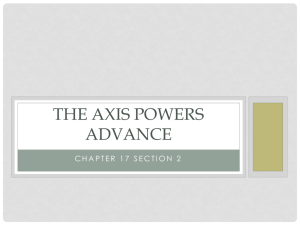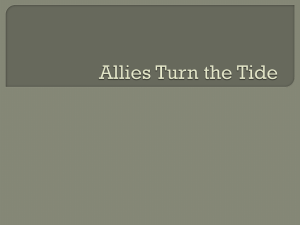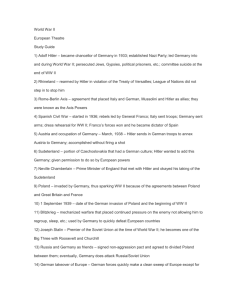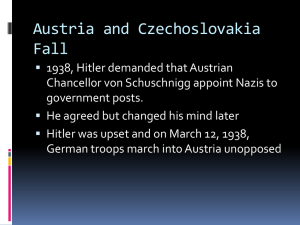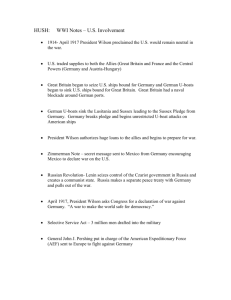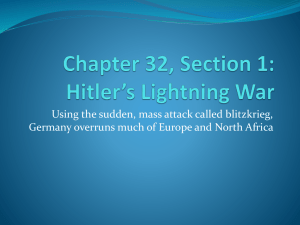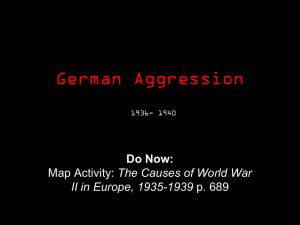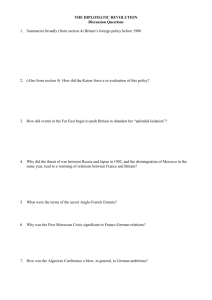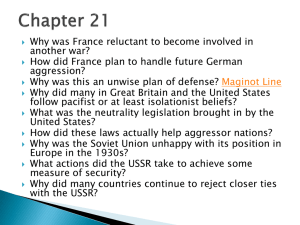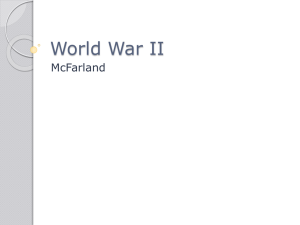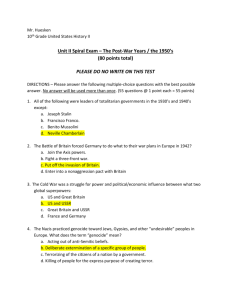PowerPoint
advertisement
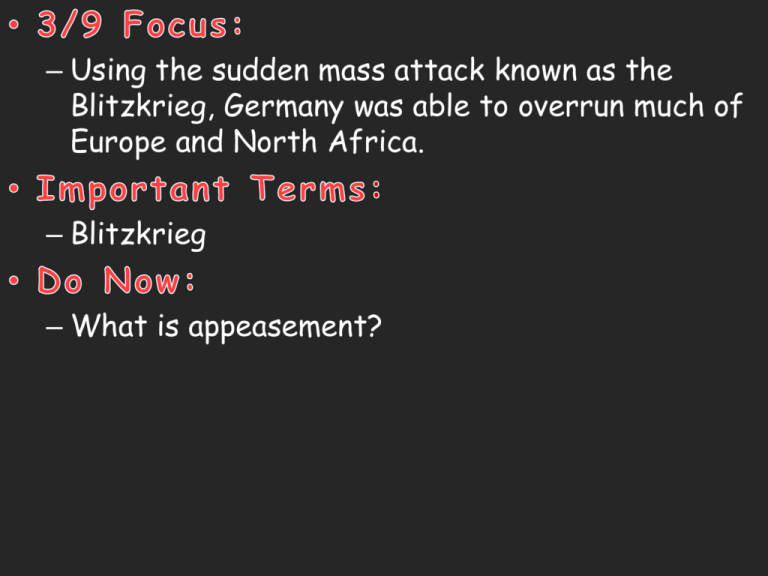
– Using the sudden mass attack known as the Blitzkrieg, Germany was able to overrun much of Europe and North Africa. – Blitzkrieg – What is appeasement? • Hitler and Stalin signed agreement to not attack each other (Aug. 23, 1939) – Agreement was to last for 10 years • Pact contained secret agreement to divide Poland between Germany and the Soviet Union • German troops invade western Poland on Sept. 1, 1939 – Britain and France (Allied Powers) had pledged to help Poland – Allies declared war on Sept. 3, 1939 – Poland fell within a number of weeks before they could get help from Allies • Soviets invaded Poland on Sept. 17, 1939 • Blitzkrieg- German word meaning “lightning warfare” – Military strategy developed by Germany – Used tanks (panzers), motorized vehicles, airplanes, and paratroopers to quickly mobilize troops and overwhelm enemy forces • Period of calm after the invasion of Poland (Sept. 1939-May 1940) – Britain moved troops to France to help with expected German invasion of France • Hitler invaded Norway and Denmark in April 1940. – Wanted to avoid possibility of a naval blockade of Germany • Germany launches attack on Belgium, Holland, and France on May 10, 1940 • France had believed that Germany would attack across their Western border – Constructed a series of forts known as the Maginot line after WWI – Maginot Line did not cover the Ardennes Forest because it was thought that Germany could not attack through the thick forest • British and French troops became trapped by German forces at Dunkirk • German forces slowed their advance – they did not want to over stretch their supply lines – Hitler decides to turn over the destruction of the allied forces at Dunkirk to the German Luftwaffe (air force) Hitler with Luftwaffe chief Herman Goering • Operation Dynamo – The decision by Hitler to hold back his army gave the British a chance to rescue their forces from Dunkirk – British sent out a request for all available watercraft to head to Dunkirk – 338,000 British and French troops were rescued by 800 ships • Allied forces could not hold back German advance • France surrendered on June 22, 1940 Hitler made the French sign their surrender in the same railcar that Germany signed the armistice ending the fighting in WWI • France was divided – Occupied France controlled by German military – Vichy France controlled by “puppet” government that answered to Germans Goering and the head of the Vichy French government Henri Petain • Charles De Gaulle formed Free French gov’t in exile – Based out of Britain – Resisted German control of France • Britain was left alone to fight Germany in Western Europe – The Battle of Britain • Italian and German forces invaded the Balkans and North Africa – The early years of the WWII went poorly for the Allies, as Britain was left to fight the Germans alone in Western Europe. – Blitz, Isolationist – What event is considered to be the start of WWII? • After the taking France, Hitler focused on trying to defeat Britain – Germans developed a plan for invasion known as Operation Sea Lion • Hitler launched an air war on Britain to take out British Air Force – Needed to be destroyed before invasion could launched • German Luftwaffe bombed British ports and cities – Known as the Blitz – Attacks on civilians were meant to weaken British will to fight • Leadership of Prime Minster Winston Churchill provide confidence for the British people • British RAF were able to inflict major damage on the German Luftwaffe – Use of Radar gave warning of incoming German attacks • Hitler was forced to cancel invasion of Britain • Hitler invaded the Soviet Union on June 22, 1941 – Known as Operation Barbarossa • German forces advanced rapidly into Russia – Got to the outskirts of Moscow by Oct. 2, 1941 • Russians began counterattack as winter set in – Germans were not prepared for Russian winter – Harsh conditions slowed German advance • Germany now faced a two front war • Many American support an isolationist foreign policy – did not want to be involved in European conflict • President Franklin D. Roosevelt provided weapons to the Allies through the LendLease Program – The early years of the WWII went poorly for the Allies but after the United States entered the war the Allies began to make gains against Axis armies – Total war – What is appeasement? • Document signed by FDR and Winston Churchill – Stated a common desire to end Nazi tyranny – Self determination for all people • United States had placed economic sanctions on Japan – Response to Japanese aggression in Asia – Restricted sale of materials used for war • Japan launched surprise attack on U.S. military bases at Pearl Harbor, Hawaii on Dec. 7, 1941 – Attack pulled the U.S. into WWII • U.S Congress declared war on Japan the next day • Germany and Italy declared war on the U.S. three days later • Japanese forces rapidly conquered strategic islands in the Pacific and territory in Asia • Allied Powers United States Britain Soviet Union Free French China • Axis Powers Germany Italy Japan • Axis and Allied powers used total war during the war – Civilian population was required to support the war effort • Democratic governments exerted control over factories and manufacturing – Ordered factories to produce war materials – Rationed consumer goods – Fixed prices and wages • Democratic governments limited certain rights and used propaganda to influence public opinion – Ex. Japanese Americans were placed in interment camps • Women worked in factories to replace men who joined the war • Some American and British women served in the armed forces – Non combat support roles • Public supported the war effort by buying war bonds • Two main theaters of the war – European theater • Allied effort led by American Gen. Dwight Eisenhower – Pacific Theater • Allied Effort in the Pacific led by American Gen. Douglas MacArthur
